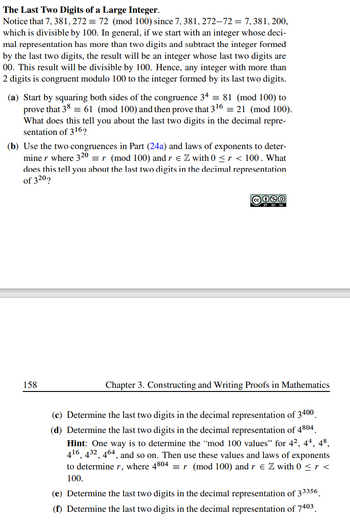
Advanced Engineering Mathematics
10th Edition
ISBN: 9780470458365
Author: Erwin Kreyszig
Publisher: Wiley, John & Sons, Incorporated
expand_more
expand_more
format_list_bulleted
Question
thumb_up100%

Transcribed Image Text:**The Last Two Digits of a Large Integer**
Notice that \(7, 381, 272 \equiv 72 \, (\text{mod} \, 100)\) since \(7, 381, 272 - 72 = 7, 381, 200\), which is divisible by 100. In general, if we start with an integer whose decimal representation has more than two digits and subtract the integer formed by the last two digits, the result will be an integer whose last two digits are 00. This result will be divisible by 100. Hence, any integer with more than 2 digits is congruent modulo 100 to the integer formed by its last two digits.
(a) Start by squaring both sides of the congruence \(3^{4} \equiv 81 \, (\text{mod} \, 100)\) to prove that \(3^{8} \equiv 61 \, (\text{mod} \, 100)\) and then prove that \(3^{16} \equiv 21 \, (\text{mod} \, 100)\). What does this tell you about the last two digits in the decimal representation of \(3^{16}\)?
(b) Use the two congruences in Part (24a) and laws of exponents to determine \(r\) where \(3^{20} \equiv r \, (\text{mod} \, 100)\) and \(r \in \mathbb{Z}\) with \(0 \le r < 100\). What does this tell you about the last two digits in the decimal representation of \(3^{20}\)?
(c) Determine the last two digits in the decimal representation of \(3^{400}\).
(d) Determine the last two digits in the decimal representation of \(4^{804}\).
*Hint: One way is to determine the “mod 100 values” for \(4^{2}, 4^{4}, 4^{8}, 4^{16}, 4^{32}, 4^{64}\), and so on. Then use these values and laws of exponents to determine \(r\), where \(4^{804} \equiv r \, (\text{mod} \, 100)\) and \(r \in \mathbb{Z}\) with \(0 \le r < 100\).*
(e)
Expert Solution
This question has been solved!
Explore an expertly crafted, step-by-step solution for a thorough understanding of key concepts.
This is a popular solution
Trending nowThis is a popular solution!
Step by stepSolved in 3 steps with 3 images

Knowledge Booster
Similar questions
- please don't provide hand wrtten solution....arrow_forwardWhy does the linear congruence 25x ≡ 30 (mod 75) have no solutions?arrow_forwardIn the following question: " Let a, b ∈ Z. Show that if a ≡ 5 (mod 6) and b ≡ 3 (mod 4), then 4a + 6b ≡ 6 (mod 8)." why do we ignore the -6 when substituting the variables of a and b, if we expand "4a + 6b ≡ 6 (mod 8)" we get (4a+6b)-6=8y, when we substitute we have to end up with the 8y right? Im just confused why the -6 is ignored?arrow_forward
- If a (mod 0) = a, How would you interpret the congruence a ≡ b (mod 0)?arrow_forward2. Solve the simultaneous congruences x = 4 (mod 5) and 2x = 3 (mod 7)arrow_forward3. Find all integer solutions to the pair of congruences (if any) x = 1 (mod 2) * = 2 (mod3) x = 3 (mod 5) x = 4 (mod 11)arrow_forward
- 1)For each of the following, find an integer value x which satisfies the equation, or explain why there is no solution to the equation. (a) 2x ≡ 3(mod 25) (b) 6x ≡ 4(mod 15)arrow_forwardFind all solutions to the following congruencies A.) 2x+3=7 (mod 9) B.) 2x+3=7 (mod 10)arrow_forwardFind the smallest positive integer xx that solves the congruence: 11x≡5(mod57)arrow_forward
arrow_back_ios
arrow_forward_ios
Recommended textbooks for you
 Advanced Engineering MathematicsAdvanced MathISBN:9780470458365Author:Erwin KreyszigPublisher:Wiley, John & Sons, Incorporated
Advanced Engineering MathematicsAdvanced MathISBN:9780470458365Author:Erwin KreyszigPublisher:Wiley, John & Sons, Incorporated Numerical Methods for EngineersAdvanced MathISBN:9780073397924Author:Steven C. Chapra Dr., Raymond P. CanalePublisher:McGraw-Hill Education
Numerical Methods for EngineersAdvanced MathISBN:9780073397924Author:Steven C. Chapra Dr., Raymond P. CanalePublisher:McGraw-Hill Education Introductory Mathematics for Engineering Applicat...Advanced MathISBN:9781118141809Author:Nathan KlingbeilPublisher:WILEY
Introductory Mathematics for Engineering Applicat...Advanced MathISBN:9781118141809Author:Nathan KlingbeilPublisher:WILEY Mathematics For Machine TechnologyAdvanced MathISBN:9781337798310Author:Peterson, John.Publisher:Cengage Learning,
Mathematics For Machine TechnologyAdvanced MathISBN:9781337798310Author:Peterson, John.Publisher:Cengage Learning,


Advanced Engineering Mathematics
Advanced Math
ISBN:9780470458365
Author:Erwin Kreyszig
Publisher:Wiley, John & Sons, Incorporated

Numerical Methods for Engineers
Advanced Math
ISBN:9780073397924
Author:Steven C. Chapra Dr., Raymond P. Canale
Publisher:McGraw-Hill Education

Introductory Mathematics for Engineering Applicat...
Advanced Math
ISBN:9781118141809
Author:Nathan Klingbeil
Publisher:WILEY

Mathematics For Machine Technology
Advanced Math
ISBN:9781337798310
Author:Peterson, John.
Publisher:Cengage Learning,

